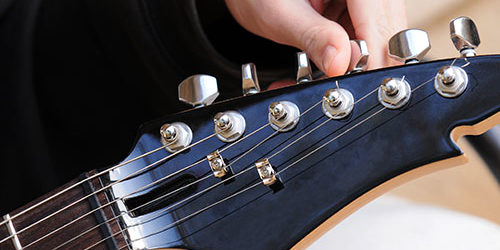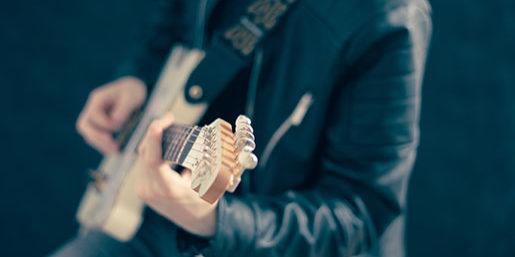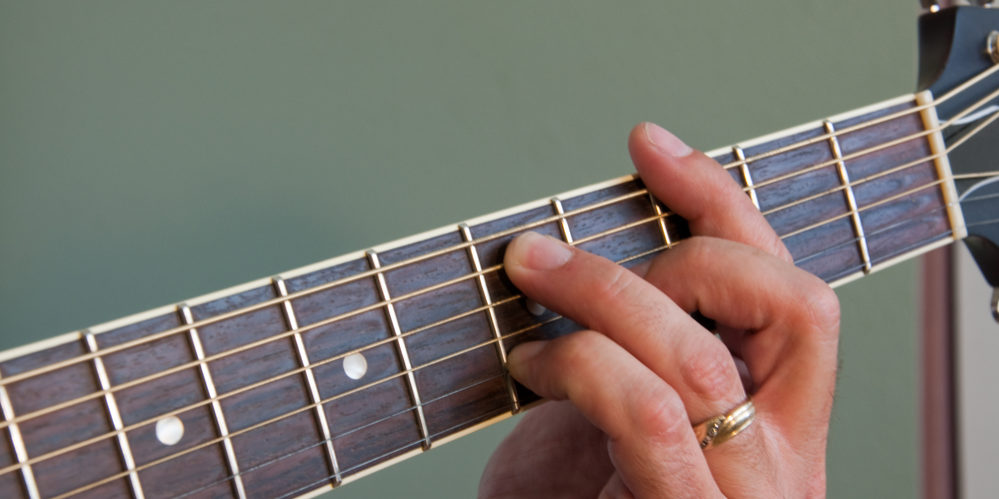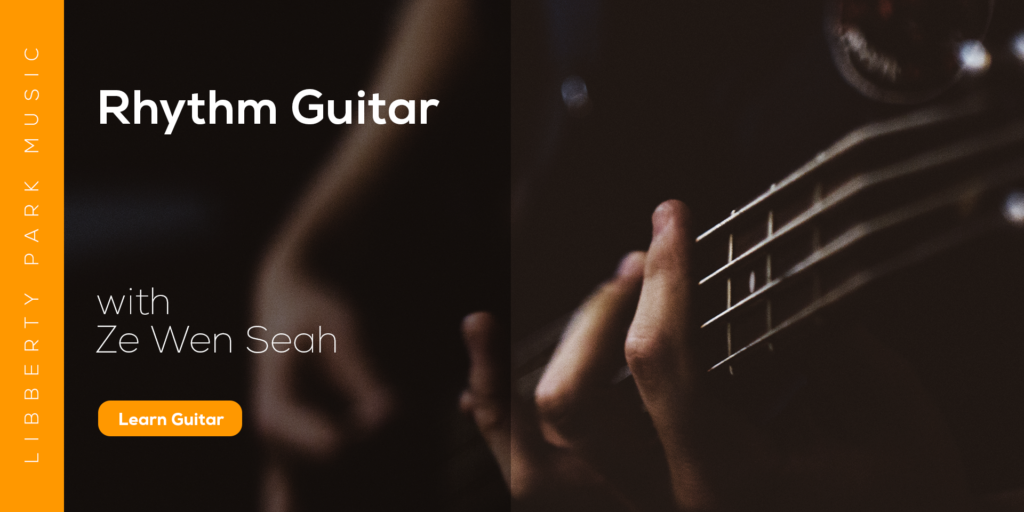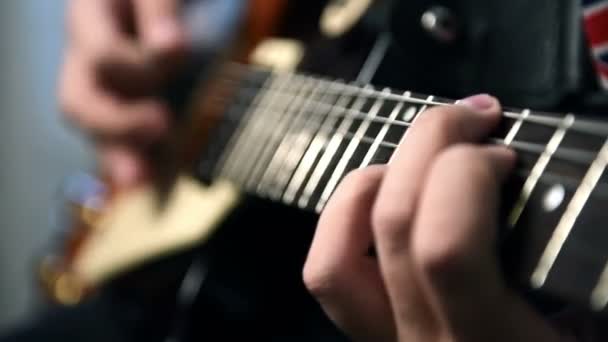
Large hands with long fingers are common physical traits found amongst some of the best guitar players. Just do a quick Google search and look at the hands of Paul Gilbert, Buckethead, John Mayer, Guthri Govan, Eric Clapton, Stevie Ray Vaughan, Jimi Hendrix, and Wes Montgomery. Having bigger hands definitely gives you an advantage when it comes to playing complex chord voicings, reaching for large interval jumps, and playing fast licks.
However, many guitar legends like Angus Young and Prince didn’t have massive digits, and just look at how they’ve transformed how we play the guitar forever. You can also spend a few minutes on Instagram watching tiny 8-year-olds shred on the guitar as if they’ve been playing for decades. If you apply the following tips, it is definitely possible to become a great guitarist despite having small hands.
Having smaller hands usually only presents problems in the fretting hand, so the following 10 tips focus mainly on working around that obstacle.
Stretch
Just like athletes stretch to improve their flexibility, musicians should stretch regularly too. In fact, problems often arise due to a lack of flexibility rather than a lack of finger length. Stretching also helps you warm up your hands before you play, which can help you avoid any potential injuries related to playing guitar.
Begin all of your practice sessions with a simple stretching routine. You can begin by massaging your hands and forearms, then proceed to stretch your wrists and each finger. Remember to stretch your fingers in different directions. Check out this video from GuitarLessons365 to get a good idea of how you should perform these stretches. The most important thing to remember when performing these stretches is they should not be painful! Do these exercises slowly and gently.
Use your pinky finger
This may sound like a strange tip, but I can’t count the number of times I’ve encountered guitarists that avoid using their pinky finger. If you have large hands, it’s easy to get away with not using your pinky as you can always stretch your ring finger to fret those notes; but if you have small hands, you’re going to have to get used to using all your fingers.
Certain chords will also be much easier to play if you use your pinky finger instead of your ring finger. For example, check out this Am9 chord.
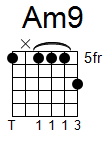
At first, it may seem like you should use your ring finger to fret the note on the 7th fret of the first string; however you’ll find that you won’t have to stretch as much if you use your pinky finger instead.
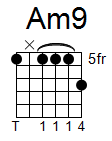
This may be a slightly complex chord voicing, but the same idea applies to any other chord or scale. If you don’t have to stretch as far if you use your pinky finger, just go ahead and use that finger then. This will ease the tension throughout your hand and arm and save you from fatigue.
Pay attention to your thumb
This tip will help you avoid injuring your thumb when playing guitar. As much as possible, you want to avoid putting your thumb over the neck, like you’re gripping a baseball bat. Instead, you want to keep your thumb behind the neck as much as possible. Generally having your thumb around the middle of the neck works well.
This rule is often broken, especially if you like to fret notes with your thumb like John Mayer or Jimi Hendrix, but having smaller hands will mean that you’ll want to avoid doing this too much as it causes a lot of tension on your thumb and wrist.
Practice
At the end of the day, any physical limitations you may encounter can be overcome if you spend a lot of time practicing. The hours you spend practicing will reveal different methods to work around obstacles and you may even end up with your own unique way of playing guitar.
Even if you’re unsure of what to practice initially, just forcing yourself to sit down and practice random things will eventually reveal the things you need to work on and the things you’ve already nailed down. To sum it up, when in doubt, practice.
Use a capo
There is an odd opinion amongst some guitarists that using a capo is equivalent to “cheating” and it’s a clear sign of a lack of skill. This can not be farther from the truth. Put simply, there are countless legitimate reasons for using a capo. Feel free to check out our previous article on how to use a capo to get an idea of why you may need to use one.
For guitarists with smaller hands, a capo is an essential tool as it can help you avoid playing too many barre chords. While it is important to know how to use your barre chords, these chords tend to put a lot of tension on your fretting hand, especially if you have smaller hands. The use of a capo and a good understanding of how to transpose keys can help you minimize the number of barre chords used in a song.
Consider buying a ¾ size guitar
There are a ton of ¾ or “travel” sized guitars currently on the market and they are perfect for people with smaller hands. Popular models include the Little Martin, Ed Sheeran’s signature Martin, the Baby and Big Baby Taylor, and Fender’s Travel acoustic guitars.
As the name implies, ¾ sized acoustic guitars are simply that -- a guitar that is ¾ the size of regular sized acoustics. The great thing about these guitars is that they usually come with a shorter neck length which will allow you to stretch across different frets easier. They’re also really light and compact which makes them really portable.
In terms of sound quality, many of these ¾ sized guitars stack up really well to their full-size counterparts. In fact, many of these smaller guitars sound so good that you can see them being used regularly by touring musicians. Do a quick search of Ed Sheeran’s live performances and you will see that he often performs with his Little Martin acoustic guitar.
Scale length and neck profile
When it comes to electric guitar, two things to consider if you have smaller hands is the guitar’s scale length and neck profile. Let’s talk about the scale length first. A guitar’s scale length is the distance between the nut and the bridge, and different guitars use different scale lengths. For example, most Gibson guitars use a scale length of 24.75 inches while most Fenders use 25.5 inches. How this translates into the fretboard is that guitars with shorter scale lengths have smaller frets, resulting in a fretboard that is easier to stretch your fingers across. A shorter scale length also allows you to perform string bends with ease as there is less tension in the strings. If stretching across different frets is a problem for you, you’ll definitely want to go with a guitar with a shorter scale length.
In order to measure the scale length of your own guitar, you can either find the specifications of your guitar online, or you can measure the distance between the nut and the 12th fret and multiply that number by two. For example, my Fender Telecaster has a distance of 12.75 inches from the nut to the 12th fret, and if I multiply that number by two, I will get 25.5 inches. The reason why we don’t measure straight from the nut to the bridge is because if you look at the string saddles on the bridge, every saddle has a slightly different position. If you’re curious about the different scale lengths of different guitars, most manufacturers provide their specifications online.
A guitar’s neck profile relates to the shape of the back of the neck. Check out the following image from Fender to get a good idea of the three most common shapes.

As you’d imagine, if you have smaller hands, you’ll want a neck profile that isn’t large or chunky. Most people opt for the standard “Modern C” neck profile from Fender as they’re easy to hold in your hand and they’re easy to navigate around. You’ll definitely want to avoid the chunkier “U” shape, or even the less common “D” shape as those neck profiles will make you feel like you’re holding onto a baseball bat. Other guitar brands have their own names for the different neck profiles, but they all generally have these three common shapes. The key point is to opt for the slimmest neck profile you can find.
Use lighter gauge strings
There are countless guitar string options on the market and each of them present their own pros and cons, but if you struggle with fretting notes cleanly due to a lack of finger strength or finger length, stick with the lighter string gauges. Lighter gauges will cause your guitar to sound less full, but they will allow you to play a lot more effortlessly.
My suggestion for electric guitars is to go with .009-.042 strings. A good brand to check out is the Elixir Super Light strings. For acoustic guitars, a good choice would be a set of .010-.047 strings. Again, Elixir makes a great set of Phosphor Bronze Extra Light strings.
While I’m currently suggesting for you to get the lightest strings possible, I do highly recommend eventually trying out thicker gauges as you may end up preferring how they feel in your hands. Personally, I prefer medium gauge strings as they’re a nice balance between ease-of-playability and tone.
Set up your guitar
This is something I tell everyone regardless if they have massive bananas-for-fingers or if they have small hands. The first thing you should always do when you get a new guitar is to bring it to a professional for an evaluation, and if necessary, get it professionally set up. A professional set up consists of bringing the strings close enough to the fretboard so that your instrument requires minimal effort to play while avoiding any unpleasant buzzing. A set up will also ensure that your guitar’s intonation is on point which helps to avoid any out-of-tune notes from arising.
It is important to note that most guitars don’t come set up properly and playing those instruments will generally result in a painful and tiring experience. It’s going to be even tougher to play a badly set up guitar if you have small hands as you will find yourself overstretching and applying too much tension on the strings. Having too much tension is never a good thing because it can lead to long-term injuries. So please spend that additional 50 or 60 bucks to get your guitar into perfect playing condition.
Don’t give up
It may seem impossible to become a great guitarist when you have certain physical limitations, but it really isn’t. There are many legendary guitarists that have lost parts of their fingers or movement in their arms, but they didn’t let these obstacles limit their ability to play guitar. They decided that they were not going to give up, and that determination led them to become some of the most influential guitarists of all time. Here are two examples of guitarists who have overcome some big hurdles in their musical careers.
Django Reinhardt
Django Reinhardt was the first and most influential jazz musicians to emerge from Europe in the twentieth century. To this day, he is still considered one of the greatest guitarists to have ever lived. He was a pioneer for the gypsy jazz genre and many of his compositions have since become standards.
In 1928, before he’d even started his first band, Reinhardt was unfortunately caught in a caravan fire which badly burned his entire body. He partially lost the ability to use his right leg and had to permanently use a cane to walk. More significantly though, he’d lost the ability to use the fourth and fifth fingers on his left hand. This was something that he’d never fully recovered from, but his determination to work around this limitation led to him mastering the ability to use just his index and middle fingers to fret the guitar. If you listen to some of his recordings, it’s actually pretty crazy how he’s able to play at such speeds while only using two fingers.
Jerry Garcia
Jerry Garcia was an American singer-songwriter and guitarist. He was one of the founding members of the rock band The Grateful Dead which was an extremely popular band during the counterculture era of the 1960s. Garcia spent his time with the band as the lead guitarist and became known for his ability to go on long, soulful guitar improvisations. He had a unique ability to blend the blues, rock, jazz, and bluegrass in his improvisational lines.
Garcia was also a big fan of Django Reinhardt’s music, and saw Reinhardt as an inspirational figure due to his inability to use his ring and pinky fingers. Garcia himself lost two-thirds of his right middle finger in an accident when he was a child. However, this didn’t stop him from using fingerstyle techniques.
These are just two examples from a long list of great guitarists who have overcome serious injuries to their hands and fingers. At the end of the day, having small hands really isn’t a limitation when it comes to playing guitar. All you have to do is keep your head down and continue working on your craft and you too can become a great guitar player. If you’re curious about what you should practice and how you should practice, feel free to check out any one of the online guitar courses available at Liberty Park Music!
About the Author: Ze
Ze first began his journey playing original music and top 40s pop tunes around the country's popular venues. Eventually, through the music of John Mayer, he found a strong attraction to blues music. Ze has years of experience teaching beginners and intermediate guitarists. Currently with Liberty Park Music he is teaching Introduction to Guitar Playing for Complete Beginners, Rhythm Guitar to learn about strumming, chords and more, Guitar Essentials as a fast-track review course, and lots of Song Lessons on pop and rock hits.


